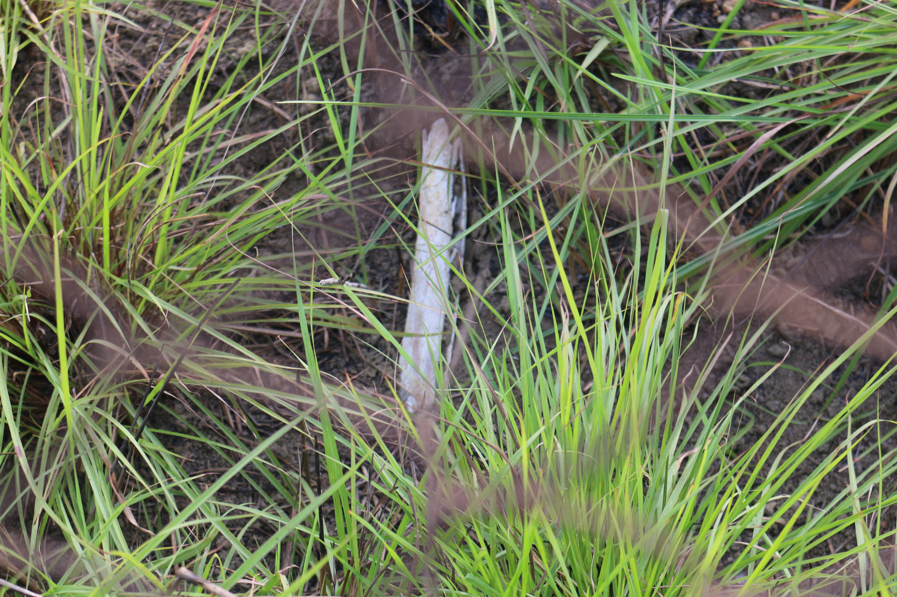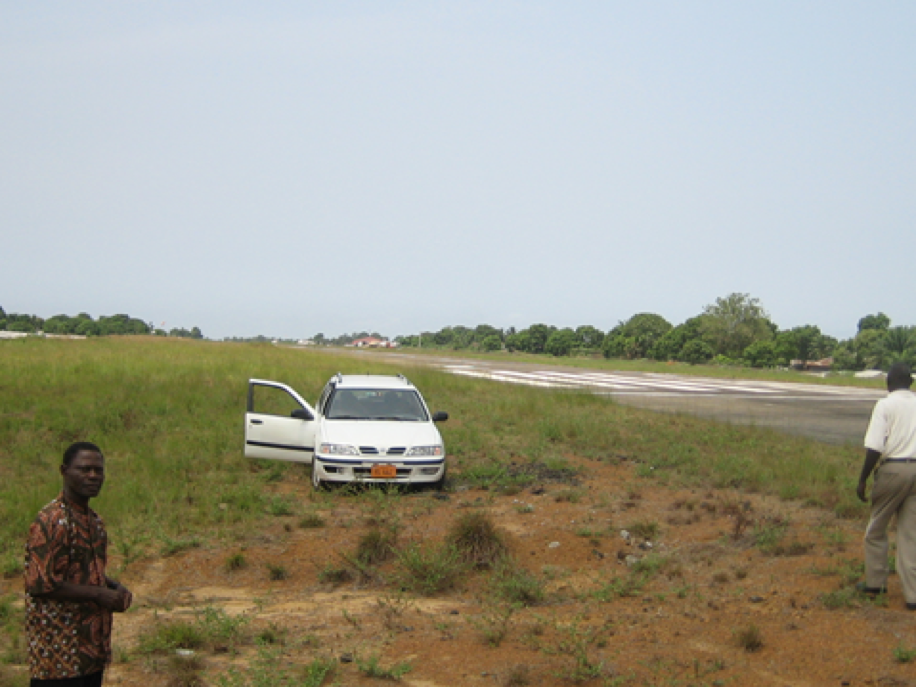
DEATH HOLE, Monrovia, Liberia – Loud weeping and low meditations, wreaths on sparkling graves, radiant tombstones with prayers that the inhabitants “Rest in Peace”, quarrels over vaults and vandalism, too. These are some of the highlights of Decoration Day, observed this year on March 13.
But the graveyard at the end of the runway of the James Spriggs Payne Airfield towards the mangrove swamp has been quiet for nearly 30 years. Survivors say many people were killed and buried here in 1990. Yet there has been no weeping or wreaths. Bones of the victims poke out between tall grasses behind the rusty, wire fence. This community on the Old Road side of the runway is called Tweh-Johnsonville but people here know it as “Death Hole” in reference to the tragedy it bears witness to.
“That time we moved here, we used to see bones in the fence, outside the fence,” says 23-year-old Hajah Zoeduah who lives in a new community within Death Hole at the end of the runway, where the killings were done. “When we used to be digging the dirt, we used to see dead body bones all around the fence,” she says.
Community chairman Stephen Korpel III Kropel says the community has not thought about a memorial for Death Hole victims but says he will discuss it with the community. “We have to give recognition to the dead, especially those that were killed,” says Korpel III.
The people killed here were predominantly of the Gio and Mano tribes, accused of being rebels of the National Patriotic Front of Liberia (NPFL). Others, survivors in this swamp-enveloped community say were students of the University of Liberia, then current and ex-government officials and immigration, police officers and ordinary people. A death squad of the Armed Forces of Liberia (AFL), loyal to then President Samuel Doe, did the killings. Many victims were people trying to cross the runway fleeing the war or looking for food. Others were arrested from their homes in Sinkor, Lakpazee, the Old Road and beyond.
The Truth and Reconciliation Commission of Liberia in its 2009 report listed this runway as one of more than 200 massacre sites across the country where memorials should be built. It also called for Unification Day to be renamed “National Unification and Memorial Day”. However, only three monuments have been erected nearly 10 years after the TRC report that has yet to happen. With a resurgence of debate on the prosecution of those who bear the greatest responsibilities of the atrocities of the Liberian Civil War (1989 – 2003), the TRC are back under the spotlight.

‘Open-air Tribunal’
The TRC did not say how many people were killed on the runway but survivors say that number could be very high, as the AFL death squad killed people on a daily basis, mainly between June and August 1990. The TRC named Captain Yuobo Tailey and Maj. Jerry Gban (both deceased), whom survivors say led the killings, among the civil war’s “most notorious perpetrators”. The TRC recommended all in that category face prosecution in a war crimes court.
The James Spriggs Payne Airfield was the army’s stronghold against the rebels’ further advancement on the capital. Soldiers set up an arsenal in executive wing of the airport. They erected a checkpoint in the middle of the 6,000-foot runway, interrogating people as they crossed. A route linking Airfield communities to their Old Road neighborhoods those days morphed into a battleground, a local version of the “God Bless You Gate” on the Kakata highway. Residents, who returned to their homes following the end of the 1990 hostilities, recall bullet casings everywhere, houses riddled with bullet marks and war graffiti all over the place.
“It was an open-air tribunal,” says George Williams, 66, a survivor of the Death Hole killings. “It was just the name tribunal but there was no record-taking. If they tell you say, ‘Go on the left (towards Lakpazee)’, that means you were safe. If they tell you, ‘Go on the right’ (towards Death Hole), that means you were going to be executed.” He says the soldiers carried people in pickups, sometimes up to 15 people.
The soldiers, Williams says, had taken him and his six-year-old son Amos Williams (the current president of the Federation of Liberian Youth) from the John F. Kennedy Memorial Medical Center on July 25, 1990. Two hundred and fifty people were killed in the JFK Massacre that day when they arrested Williams and his son, according to the TRC. Williams says he spoke Grebo to convince AFL soldiers he and his son were not Gio or Mano, but those who couldn’t speak their vernacular were killed.
One memory of that day that still haunts him is how the soldiers killed three men who tried to escape. “They were running away to cross the airfield to…Tweh-Johnsonville when Tailey gave order, ‘Bring them down’. After they were shot…those soldiers that were on the other side of the [runway] took machetes and started butchering those people. Can you imagine that? The other guy as he chopped those guys, you could see blood splashing. Then he started wiping the cutlass. That was the first time I saw somebody being shot [with] a gun,” says Williams, who was 38 at the time.
Clement Cummings, a 79-year-old resident of Death Hole, who stayed in a house very close to the runway during the war, says scenes of people being shot and hacked while trying to flee the soldiers were commonplace. With no walls surrounding the airstrip then, Cummings and his family had a perfect view of the horrors.
“Sometimes they shoot. Sometimes they cut their heads off,” Cummings says. “Sometimes we would stand up and watch them. They would throw the head up first, then next the body near the head,” he says, adding he survived one runway ordeal himself when he was accused of being a rebel supporter.
Cummings also recalls how Matthew Tweh, one of the two men after whom “Tweh-Johnsonville was coined (the other retired General J. Samuel Johnson), survived the runway killings. The soldiers picked him up from the Sophie community in Oldest Congo Town and brought him on the runway. He was only saved, according to Elson Nebo, his nephew, upon the intervention of the late Jackson E. Doe, brother of then President Doe.
“When I saw my uncle being brought back in a pickup, I ran away,” Nebo says. “I said, ‘I saved my uncle [once already] and now they’re coming again,’” he says. He is referring to a previous incident when he was arrested alongside two other relatives when the soldiers came searching for Tweh. Tweh later fled to Ghana. He died in 2014 of natural causes.
The soldiers also killed a number of well-known people from Lakpazee, Key Hole and Death Hole itself on the runway. From Key Hole they killed Samuel Greene, Sr., a former Deputy Minister of the disestablished Ministry of Planning and Economic Affairs, his wife and son. From Lakpazee, they killed four relatives and one tenant from the house of Dominic Giple, a prominent businessman. And from Death Hole they killed John Martin, Sr., a former inspector with the Ministry of Commerce and Industry. Evade
Both Martin and Greene were killed under nearly similar circumstances in August 1990, according to witnesses. The Greene and family fled Key Hole for a relative’s house in Sinkor. The soldiers accused Greene of communicating with the rebels. The soldiers accused Martin of being a runaway policeman after they saw his inspector uniform.
“That’s on the airfield they killed Mr. Martin around about 4 O’clock,” says Isaac Logan, 59, who says he was with the doomed Commerce inspector when he was picked up on 15th Street in Sinkor. “When you hear about mass grave at the end of the runway, that’s Mr. Martin [and others].”
Samuel Greene, Jr., who lived in the United States when his parents were killed, says he is “devastated” by their death. “I say prayers [on Decoration Day]. I don’t even know where their grave is.”
Ghost of Quiwonkpa failed coup
The Death Hole Killings, survivors say, were not the first hostilities they witnessed of the Doe regime against the people of Nimba. After Colonel Thomas Quiwonkpa, a Mano, failed in an attempt to topple the regime in November 1985, it led a purge of Gios and Manos as well as supporters of the aborted coup. According to the New York-based Lawyers Committee for Human Rights in a 1986 report, an estimated 400 to 2,000 people were killed in that purge that extended to Nimba County: “Nimba Raid”. It was the enmity between the Doe regime and Nimba that led to the Liberian Civil War.
Weeks, who lived adjacent to the airport’s terminal, was one of the victims. Quiwonkpa had appointed Weeks as head of the Liberian Air Reconnaissance Unit in a government he envisioned in an ill-fated broadcast on state radio. Matthew Morris, 59, who moved to Death Hole in 1968, says he witnessed Weeks’ family neglect their home following his death in 1985. No one lived there again until it was destroyed during the war, says Morris, who on three occasions survived the runway killings.
Morris says he also witnessed the death of the family of John Nuan, one of the 1985 failed coup plotters killed in the purge. The AFL death squad, he says, arrested everyone in their house—including children—and took them at the end of the runway. “It was one hot sun. Everybody was just standing and the people were crying as the soldiers where carrying them,” he says.
The Independent Human Rights Commission (IHRC)—established to implement the TRC recommendations—has only erected the Du Port Road and Maher Memorials. Another memorial was erected in Samay, Bong County but was done by the townspeople. The Commission says it has funding to erect one in each county. With the Du Port Road already done for Montserrado, a memorial for Death Hole victims might not come any time soon.
Williams urges the government to erect a memorial to dignify the people killed in Death Hole and other places. “Let it be a wide area, with the monument in the center so that people can go and lay their wreath there.”
This story first appeared on FrontPageAfricaOnline as part of a collaboration for the West Africa Justice Reporting Project.
